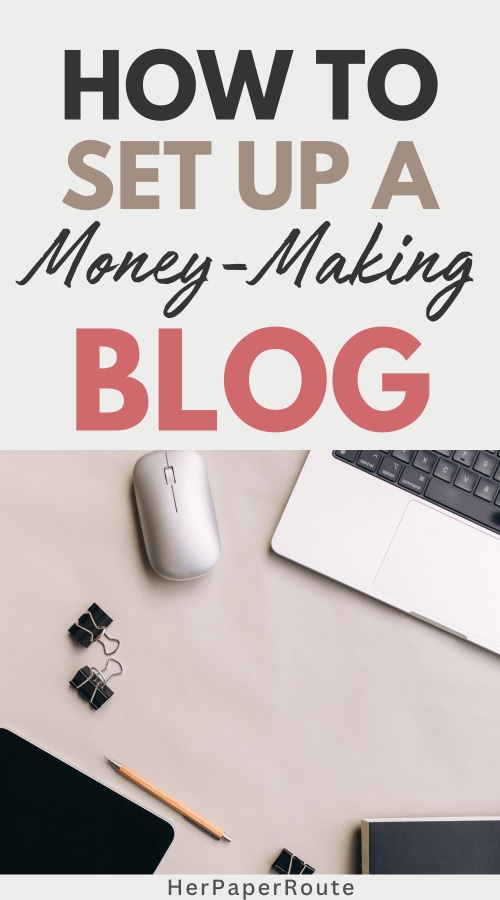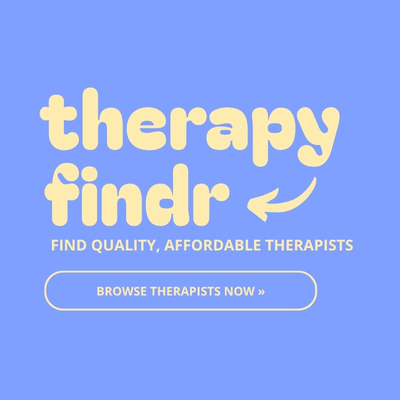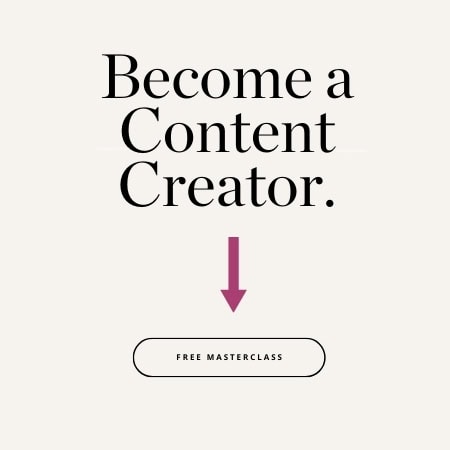How To Set Up A Blog And Get Paid For It

Would you like to know how to set up a blog but aren’t quite sure where to start? You’ve probably been reading income reports about bloggers who are making thousands in only a few months.
While the few months’ timeframe is rare, it actually IS possible to get paid for your blog and make a good amount of money.
As an affiliate partner of various brands and sponsored content, HerPaperRoute may earn commission on qualifying purchases. Disclaimer
Step-By-Step Guide For Setting Up A Successful Money-Making Blog
This article goes into great depth and detail on how to set up a blog and get paid for it. It’s not your typical “start a blog” post with little actual help.
There are tons of actionable tips and tutorials on setting up your blog correctly and the steps for making money. I recommend you use the Table of Contents below to help navigate.
Section 1: What Is A Blog And How To Choose A Niche That Makes Money
Choosing your niche is one of the most important parts of blogging. It’s also one of the areas few new bloggers do any research into.
How to pick what you’re going to write about takes a little research at the beginning but will make your blog much more profitable in the long-run.
I use and recommend BigScoots for quality website hosting, and Namecheap for buying your domain.
What is a blog?
A blog is a website that is updated frequently with articles and other new content. Typically the writing is done in an informational but conversational style.
A blogger can let some of their personality shine through while helping their readers with their problems. Even some large news sites such as CNN have blogs so at this point, they’re pretty mainstream.
Is it too late to start a blog?
I can answer this with a resounding “no!” While blogging has changed over the years, people still have questions they want answered.
I started this blog in 2018 and even then there were people saying it was too late to start a successful blog that makes money. They’d be wrong.
If you’re committed to writing content that helps answer your reader’s questions and not focusing on yourself, then there is still a market that earns money.
How long does it take to make money blogging?
The latest research shows that over 70% of blogs don’t make money. That’s a lot of time and effort going into something that is essentially a hobby.
I’m going to be honest and tell you that blogging is a lot harder than you think.
Long gone are the days that you could slap up a 500-word article about what you did on Saturday and have Google send you traffic.
For at least the first 3 months, you’ll probably have no traffic aside from friends and family. It’s only at months 6 and above where you can start getting a trickle of traffic from Google if you’ve written your posts for search engine optimization.
Using Pinterest is another way new bloggers get traffic but the platform has changed a ton recently and it’s no longer a plethora of free traffic. It takes more time to build your account and pins are less viral.
When you start getting traffic to articles that sell your own products or affiliate links (other people’s products but you get a percentage), you’ll start earning a small amount of money.
So many bloggers quit within their first year because they went into it with unrealistic expectations. They often read other bloggers’ income reports about how they made hundreds of dollars after only 3 months of blogging.
It’s highly unlikely that a brand new blogger will have the knowledge or expertise to start earning that fast unless they have prior knowledge.
To realistically start seeing blogging success, you’ll need to commit to working at it for 12-18 months before giving up. If this sounds like something you can do, then keep reading for all the nitty-gritty details.
How To Pick A Niche For Your Blog
Selecting your niche is the most important first step in your blogging journey. A niche is another word for the main topic that your blog will cover.
While it’s good to choose a topic that you enjoy and are passionate about, if your goal is to make money, you need to have a critical eye.
Not all niches are as profitable as others. If your aim is for passive income streams through affiliate marketing, some niches have very few readily available options.
For example, if you’re passionate about dominos, how would you monetize that? Is there a large amount of the general public searching for your topic? One person can only buy so many sets of dominos before their lifetime domino needs are met.
It’s important to keep this in mind when looking at niches.
Here are some of the most profitable blog niches:
- Health/Fitness – People are always looking to become healthier and in shape. Fitness plans, healthy eating, and living are popular topics.
- Wealth/Money – This can be anything from investing, stocks, personal finance, or making money.
- Parenting – A lot of stay at home moms start blogs to share their parenting adventures.
- Travel – If you travel frequently or live in a vacation town, then this could be a good option for you.
- Food – Perfect for someone who likes creating recipes and can take drool-worthy food photos.
- Sports – Some sports are a lot more profitable than others. For example, golfers are more likely to spend more on equipment than someone who loves bocce ball.
- Beauty/Fashion – This niche lends itself well for someone who also likes being on Instagram to help drive traffic.
- DIY/Craft – This can be a very profitable niche if you find the right affiliate program or sponsorship. You can build your entire blog around just one main affiliate item and become the go-to expert.
With niches that fall within the Your Money and Your Life topics (health, finance), Google is ranking blogs higher whose authors have credentials and authority in those fields. (ie, doctors, certified financial accountants) If you don’t have health or financial training then it will be much harder to build authority in those niches.
Other Tips For Niche Research
When you’re researching niches, look into their profitability by searching for affiliate programs. In Google type in your niche followed by “affiliate program.” This will show you what’s out there so you can see if it’s items you’d want to promote or not.
Another way to research the niche is to look for income reports of other blogs in the niche. If doing this method, use a critical eye because many of them over-exaggerate or don’t factor in their expenses. Often, they’re trying to sell you their blogging course.
Why you shouldn’t choose the Lifestyle niche:
Lifestyle is another popular blog niche for new bloggers. I don’t truly consider it a niche though. A lifestyle blog will typically cover a few niches such as beauty, parenting, and travel.
While it sounds great in theory, it’s a lot harder to build authority and get high in the search rankings, especially when you’re competing with other niched-down sites.
If one day you’re writing about the best family vacations and the next you’re covering the best leggings for your body shape, how is Google supposed to know how to classify you?
I do not recommend starting a lifestyle blog at the very beginning.
If a lifestyle blog is really really what you want, then I suggest doing it in stages. Choose just ONE niche at first, build up a lot of content and authority, and then slowly add another niche into it, and so on.
I’m not saying you can’t be successful with this niche, it’s just that the success stories are fewer and farther between. Your goal is to have a blog that makes money, right?
Section 2: How To Set Up A Blog Correctly
In this section, I’ll go over the more tech-related side of blogging. I’ll show you how to get a domain name, pick hosting, and get started.
1. Picking A Domain Name
Your domain name is the name your website will be known as. It’s what you put in the URL bar and how people will find you.
✅ I’ve bought domain names through Namecheap and highly recommend them. They offer free privacy protection so your home address isn’t listed on the internet. (most other domain registrars charge for this)
Take your time picking a name because it’s more difficult to change your domain name later on. Trust me, I’ve done it. I wish I had taken more time choosing a name from the start.
Domain names that are shorter, easy to spell, and include one word that relates to your niche are best. Dot coms are also the best since that’s what most people will assume you have.
Go to Namecheap to see if the .com you want is available.
Tips for picking your domain name:
- Make it short
- Make it catchy
- Make it memorable
- Avoid unique spellings
- Make sure the .com is available
Another thing new bloggers overlook is to make sure the name they want to use isn’t infringing on trademarks. While your blog may be small now, as it grows, it’s more and more likely to get on the radar of the original trademark owner.
You definitely don’t want to be in litigation with a trademark owner who is asking for financial compensation since you infringed on their name.
While I’m not a lawyer and can’t guarantee whether a name is a good option, check the USPTO to see if there are any current trademarks for the name or variation of the name you want to use. You can also contact a trademark attorney to do a trademark search for you if you’re not sure.
2. Choose A Blogging Platform
Your blogging platform can have widespread effects on the success of your blog. There are a lot to choose from so I’ll make it easy for you.
What is a blogging platform and why should I care?
A blogging platform is the service or software that allows you to publish content on the internet. This is different than a blog’s theme which is more the superficial optics of how a blog looks.
There are multiple blogging platforms and some are heavily advertised. Some are even free and others will cost money.
Here are the most common blogging platforms.
- WordPress.org
- WordPress.com
- Blogger
- Wix
- Squarespace
- Medium
- Constant Contact Website Builder
- Gator
Keep in mind that it will be very difficult to make money using a free platform. For one, you don’t own it. The platform does and they have limitations on what you’re able to promote.
Second, the platform may decide to put their own ads on your site and you don’t get any of the profit. You have no say in this and the sites often look unprofessional because of it.
Third, you may not be able to join an advertising network, or the platform setup may not be optimized for search engines. There is also limited support and customizations available.
All of these points factor in getting your content seen and ranking. The best option is going to be WordPress.org.
WordPress.org vs WordPress.com
WordPress.org and WordPress.com are the same software. The main difference is that with WordPress.com, your blog is being hosted by them for free.
This takes away a lot of your ability to earn. You aren’t going to make money on a free platform.
Instead, use WordPress.org. You will own your blog this way but you’ll need to install it on a host which I’ll explain in the next point.
WordPress vs Wix or Squarespace
WordPress is the most used blogging platform in the world and makes up 34% of all websites. Some of the biggest brands in the world are using WordPress as well.
They offer the best for customizability, scalability, and monetization. You also have complete control over the platform.
There is a slight learning curve when learning WordPress which is why some people opt to start with Wix or Squarespace. Those platforms are drag and drop builders that are easy to use.
The problem comes with all the behind-the-scenes tech stuff. Those platforms aren’t optimized and it’s unlikely you’ll earn much using them.
It’s also an expensive headache to transfer your blog down the road which is why I recommend starting with WordPress.org from the get-go.
3. Buy Web Hosting
Even though the WordPress.org software is free, you’ll need to host it on a server. This is where web hosting comes in.
✅ After doing tons of research, I confidently use and recommend Bigscoots for web hosting.
What is a web host?
A web host is a company that stores your data on their servers. You pay them to host your blog so that you can be seen on the internet.
How much does web hosting cost?
There are a wide range of costs for web hosting from $4.30 per month to over $100. When you’re starting out, you can purchase the least expensive plan and upgrade as you need to with increased traffic.
Why NameHero Is The Best
Over the years I’ve used a few hosting companies and I must say that Bigscoots has by far been the best in terms of affordability, customer service, and actually delivering what they promise.
- Reliability – They aren’t down for maintenance or technical issues as often as other hosting companies.
- Extremely fast servers – Website speed is becoming more and more important for Google. Start off fast instead of trying to fix speed issues after the fact.
- USA-Based – They have servers in the USA instead of being hosted overseas. The location of the servers drastically affects your site’s speed.
- Amazing customer service – If you’re having trouble with something, their help is fast, knowledgable, and doesn’t try to upsell you into unnecessary features.
- Grows with you – They are a complete web host and have plans that can accommodate even huge websites. As you grow, you can upgrade your service plan instead of going through the inconvenience of hopping hosting companies.
Honestly, they’re the best affordable hosting for beginners and beyond.
My Experience with BlueHost (and Why I Don’t Recommend Them)
I actually started out on BlueHost. Many of the big bloggers promote them so I assumed they were the best.
After I had signed up for a 3-year contract, I started having issues. Every time I contacted tech support, each person would give me conflicting information.
My website would inexplicably be down throughout the month and I wasn’t notified. I had to bring the server issues to their attention. Their servers were older and slower than newer ones.
What ultimately made me leave them was after spending hours trying to get help with my site, they said they couldn’t help me and I’d need to purchase a security package for around $300.
My site speed had tanked, I never knew if my site would be up or down, and they tried to sell me something I didn’t need rather than fixing the server issue.
Yes, their plans are slightly cheaper initially but it’s not worth the stress, time wasted, and additional money spent on outside tech help.
Your experience may be different than mine but I was over all the issues I was having.
4. Installing WordPress
Once you have purchased your webhosting plan, you’ll need to install WordPress on Bigscoots. Follow the steps in this guide for what to do here.
5. WordPress Settings Setup
I recommend you take your time going through this section. Settings can be confusing but just follow along and go step-by-step.
Logging In To Your WordPress Blog
The easiest way to log in is to add wp-login.php to the end of your domain. For example, https://yoursite.com/wp-login.php will get you to the login screen.
Please note that if you recently registered your domain, it’ll take 24-48 hrs for all the proper domain redirects to take effect. Until then, log in directly with Namcheap to get to your blog.
Your WordPress Dashboard
Once logged in, you’ll see a setup similar to below. I know it seems overwhelming now, but you’ll get used to the setup fairly quickly.
On the left-hand side is a menu. Take some time to familiarize yourself with where everything is.
WordPress dashboard menu tabs:
- Posts – This is where you’ll be creating all of your articles. Posts allow for comments whereas pages do not.
- Media – All of your pictures and other media on your blog can be found here.
- Pages – Similar to posts but mainly used for standard content such as an about page, privacy policy, terms & conditions, etc.
- Comments – When people leave comments on your posts you’ll find them here.
- Appearance – You can change your theme and customize how your site looks.
- Plugins – Go here to add plugins or change plugin settings.
- Users – You can manage all of the users for your site. Make sure you change your main user from the standard Admin to something hackers are less likely to guess.
- Tools – More technical stuff that imports/exports data. Unlikely you’ll use this frequently.
- Settings – An important tab that needs to set up properly from the beginning.
How To Set Up Your Blog’s WordPress Settings
You can look through all of the sub-tabs of Settings but you’ll want to make sure the General and Permalinks tabs are set up properly.
General Tab
Site Title: This is the name that you want to appear for your web page. It should be the name of your blog. Mine is listed as Money Tamer.
Tagline: This is a short saying that lets readers know what your site is about. Using at least one keyword that explains what your site is about is helpful.
WordPress Address & Site Address: Both of these will be your domain name. With NameHero you get a free SSL certificate for your site so make sure that is activated. It makes your site more secure but also means you’ll use https:// instead of http:// at the front of your URL.
Email Address: This is the main email address you’ll use associated with your business. It can be your domain email set up in NameHero or a Gmail address if you prefer.
You can leave the other general settings as-is or play around with them.
Permalinks Tab
This is the setting most new bloggers overlook and it bites them down the road.
What is a permalink?
A permalink is the full URL you see for every page, post, or other content on your site. They should be easy to read and user-friendly instead of lots of numbers and symbols.
Why shouldn’t you change permalinks after a post is published?
A permalink is how a particular piece of content is identified. For every new piece of content on your site, it’s given a permalink and added to your site’s index.
This index is what Google bots crawl. If you start changing your permalinks, then Google doesn’t know where any of your content went and you’ll lose post rankings.
Also, any site that linked to one of your posts will now have an error message when they go to the old permalink. This is all very bad for SEO so it’s only recommended to change permalinks down the road with the help of a tech person.
How To Set Up Permalinks Correctly
In your WordPress dashboard go to Settings>Permalinks and make sure the button by Post Name is clicked.
It may already be automatically checked but it’s important to check before you start doing any real work on your site.
6. Deciding On Your Blog’s Theme
After WordPress has been installed, you’ll need to select a theme. You can always change this later so it’s not a huge deal.
What is a theme?
A theme is a framework for how your blog will look visually. This includes things like font, colors, page setup, navigational menus, etc.
I recommend Kadence themes because they are one of the fastest themes and fully customizable. The free version is more than great for starting out but for additional customizability, you can get the pro version. I upgraded to Pro and can make my blog look exactly like I envisioned.
Even the free cersion has easily customizable starter templates you can choose from to import and play around with.
I don’t use a page builder with my site and instead, do everything with Gutenberg blocks. The choice is yours though. (Don’t use a page builder for your posts or it will slow your site; pages only.)
To add a theme to your site, go to Appearance>Theme>Add a new theme.
What Makes A Good WordPress Blog Theme?
A good theme does more than look pretty. It needs to:
- Not have bloated code that slows your site.
- Be responsive for desktop and mobile.
- SEO friendly for schema.
It doesn’t matter how nice a site looks if it’s slow and difficult for search engine bots to crawl.
Kadence vs Genesis Framework
Kadence and Genesis are two of the most popular blogging frameworks. You can’t go wrong with either but there are some differences you should be aware of.
Kadence’s framework is free and many of the starter templates are free as well. It’s only the additional customizability that Genesis offers that you have to pay for.
Genesis is the framework you have to pay for and then you also need to buy a Genesis child theme. The theme is mostly set up already and you can customize a few things from it without needing to code.
With Kadence, you can customize pretty much everything without adding a single line of code. That’s a game-changer for someone who isn’t a coder.
I initially started out on Genesis Framework but was having to pay my tech person to change simple things like font colors and header size. It was frustrating because I wanted to be able to do it myself.
When I heard about Astra, I jumped on board and haven’t stopped recommending them since. They’re considered one of the fastest and most lightweight themes on the market.
I can now customize everything myself which saves on cost. If you have an understanding of code then Genesis may work well for you.
One thing to remember is to not get too caught up in creating logos and constantly tweaking your blog’s design. In the beginning, your content matters far more than your design. Instead, spend your time and money on content creation.
7. How To Customize Your Blog’s Theme
Once your theme is uploaded, go to the blue Customize button underneath the theme or go to Appearance >Customize on the left-hand menu.
Once in the Customize view, you’ll have a similar menu on the left like in the screenshot below. The left-hand side will have a variety of sections you can change and tweak to your liking.
As you change the menu options on the left, you’ll be able to see the changes on the right. They won’t go into effect on your blog until you publish the changes by clicking the blue button on the top of the menu labeled Publish.
Here is what the Customize menu items mean:
- Global – This will change the settings for the entire blog. It has options for typography, colors, buttons, and more.
- Header – This includes your site’s identity options, logos, headers, and navigation menus.
- Breadcrumb – You can choose whether you want navigational breadcrumbs to be shown or not and where.
- Blog – This sets how your standard blog posts and blog archive pages look.
- Sidebar – You can set the defaults for your sidebar if you have/want one.
- Footer – Controls how the footer of your blog looks.
- Menus – Sets what actual pages you want in your navigational menus.
- Widgets – Add or change widgets to your sidebar or other areas.
- Homepage Settings – Decide whether you want a static page (like I have) or a blogroll style where your latest posts will be shown first.
- Additional CSS – If you know code, this is where you can add it to additionally customize your blog.
It’s going to take some time to get your blog to look like you imagined. That’s why I’m a huge fan of Kadence‘s templates. It takes a lot of the guesswork out of making your blog look amazing from the start.
8. Posts, Pages, and Categories Setup
Before you write your first post, you’ll want to set up your essential pages and define your categories.
How To Create A New Page
On the left menu, go to Pages > Add New. You can add your title and all the content you want on the page.
To save your work, click the Save Draft option on the upper right menu. When you’re ready to publish, go to the Document tab and scroll down to the Permalink to make sure that is how you want it to be.
You can change it now before publishing if you’d like. Keep it short and sweet with dashes in between each word. Once everything looks good, click Publish to have the page go live.
Essential Pages For Your Blog
- Legal Pages
- About Page
- Contact Page
What legal pages does your blog need?
Since you’re running your blog as a business, there are three essential legal pages you should have. A privacy policy, disclaimer, and terms & conditions.
✅ I recommend and use this legal bundle which includes every legal policy you need to get started. The creator, Amira, is a lawyer who is also a blogger so she knows what bloggers need to protect themselves.
A privacy policy lets your readers know what private personal data is collected from them, how it will be used, stored, and protected.
A disclaimer policy lets readers know your content is for educational or entertainment purposes only to limit your legal liability.
Terms and conditions help protect your content from copyright infringement, refund/exchange policy, dispute resolution, and protect you from legal action from errors or omissions on your website.
Instead of buying each one individually, I recommend getting all three at a discounted price. Another plus is how easy they are to use. You change a few highlighted text with your information and you’re good to go!
Link to all three pages in your blog’s footer so that they are readily available on every page of your site.
Can you use free legal templates?
I wouldn’t recommend using free versions you find online. The biggest problem is that you can’t verify they were created by a lawyer. There’s no guarantee that they’ll actually protect you or hold up during a legal proceeding. That’s the whole point of them, right?
Can you copy and paste legal pages from someone else’s blog?
Definitely not! That’s considered stealing from the person who created the documents.
Lawyers who sell legal templates keep track of everyone who has purchased their items in their online stores so they can easily find out whether you purchased from them or not.
Do it right from the start and purchase your own legal templates that are prepared by a bar-certified lawyer. It’s so much cheaper than litigation or having an in-person lawyer make them for you.
How To Write An Amazing About Page
Not many people will visit your About page but for the ones that do, it should really wow them. Your about page isn’t actually about yourself. That’s why it’s called an About instead of About Me page.
Readers want to know what YOU can do for THEM. The tough truth is that your blog’s visitors don’t really care about you (unless your mom is reading your blog).
Your successful blog will be about helping readers with a sprinkling of your personality throughout.
About Page Essentials:
- Define who your blog is for. What will they learn on your blog?
- Why can you help them? Explain your credentials and relevant achievements.
- End with an action step. Where would you like them to go or do? (make it easy and have a link or newsletter signup)
What is a Contact Page?
A contact page has ways that people can easily contact you. It can either be a form you fill out or your email address listed.
How To Add Categories To Your Blog
Categories are the main topics of your blog. They are what each post you create will be labeled as to help organize your topics and make it easy for readers to find what they’re looking for.
Generally, you’ll have between 3-5 main categories. You can start out with fewer and add more as your content grows. You can even add sub-categories down the line to organize even more.
To add categories, on the left-hand menu go to Posts > Categories. These categories can go on your header menu.
Think about what will make the most sense for the articles you want to write.
If you’re not certain yet, you can always come back to this after you plan out some of your articles.
Name
This is the name of the category that will be displayed.
Slug
This is the URL for the category. There’s no need to change this from the category name.
Parent Category
You don’t have to use parent categories but it makes more sense later on as your content grows. For example, you could have a category called Personal Finance and then have Budgeting, Debt, Investing, etc. underneath it.
To do this, you’d create your main Personal Finance category first and don’t set a parent category for that. Then create all the other sub-categories and put Personal Finance as the parent category for them.
Description
You can write a few sentences describing each category. It is theme-dependent on whether this will actually be shown anywhere.
9. Navigation and Menus
Your goal is to keep people on your blog as long as possible. One way to do that is by having easy-to-use, clear navigation.
While the majority of your visitors will come from Google or Pinterest straight to a specific article and hop back off, linking to other articles throughout your post and having a clear menu will help keep them around.
Make sure you’ve made all your essential pages and categories before creating your menus so you have stuff to add to them.
Go to Appearance > Menus. Then either create a new menu or choose one from the drop-down bar to edit.
Choose from the Add menu items area to add Pages, Posts, your own links, and more. You can drag and drop them in the Menu structure to rearrange their order.
Section 3: How To Write Blog Posts for SEO
SEO is something a lot of new bloggers put off at the beginning. They get overwhelmed with everything else and first focus on Pinterest.
I consider this a big mistake. SEO is a long game and it can take 6-8 months for a post to start reaching its ranking potential. Wouldn’t you rather write a post that can rank from the start instead of having to go back over all your old posts?
That’s why I’m covering SEO before I delve into Pinterest and other methods for traffic.
What is SEO?
SEO stands for Search Engine Optimization. It’s how you structure your blog posts so that it’s easy for search engines, like Google, to read and send you lots of free organic traffic.
Why is Google traffic considered the best?
Google is the largest search engine in the world with over 3.5 billion searches per day. If your site could even get the tiniest sliver of that, you’d have an astounding amount of traffic.
Google traffic is:
- Extremely Targeted – People are searching for answers to their questions. Unlike Pinterest where users are scrolling as a way of entertainment. Because Google users are searching with a purpose, it’s a lot easier to recommend an affiliate product or to get them onto your email list.
- Mostly Consistent – While the Google algorithm goes through numerous updates every year, if you write a post that helps your readers and ranks well, it will usually stay fairly consistent. The Pinterest algorithm, on the other hand, seems to be changing every other week. Sometimes it doesn’t seem like Pinterest even knows what’s going on.
- Fairly Passive – Once you’ve done the hard work of writing an epic blog post, you don’t have to do a lot of maintenance. You should update your posts a few times a year to keep them relevant and fresh but you don’t have to constantly create pins and maintain boards like on Pinterest.
How To Use SEO To Get Traffic To Your Blog
Here is the process I use before writing every post. If done correctly, you’ll get thousands of pageviews every month and your domain ranking will rise, making it easier to go after more competitive keywords down the road.
1. Initial Keyword Research
If you want to create a blog that gets you paid, you’ll need to keep a narrow focus. Since you’ve decided on your blog’s niche, narrow down even more and decide what you’d like your blog to be known for.
The more you niche down and have articles on a particular subject, the more Google will see you as an authority on that topic.
For example, if your niche is backyard gardening for beginners, think of some questions or topics someone searching in your niche may have.
- How to make a backyard vegetable garden
- What vegetables are good to grow for beginners?
- How to keep pests from ruining my vegetable garden?
But how do you know if anyone is searching for these terms or how difficult they are? Keep reading for my keyword research tips.
2. Long-Tail Keywords And Why They’re Good
When it comes to finding topics for blog posts I know will do well, I focus on long-tail keywords.
What are long-tail keywords?
Long-tail keywords are phrases made up of 4 or more words. You want to focus on these phrases because they are very specific which makes it easy to write targeted blog posts.
Also, the competition for these longer keywords is usually far less. As your new blog starts ranking well with searches that have lower search volume, you’ll gain trust in Google’s eyes so that you can start ranking for the higher searched terms.
Remember, Google wants to show people content that answers their questions accurately and helpfully.
3. How To Do Keyword Research For SEO
I’m going to walk you through how I do keyword research using completely free tools. I use the Google Chrome browser and two free Google Chrome extensions: MozBar, and Keyword Surfer.
You’ll need to install both of those extensions to your browser.
Using the example above, I’m going to search in Google the term “how to make a backyard vegetable garden.”
You can see that Keyword Surfer estimates the monthly USA traffic for this term is 20 per month. This is purely an estimation and many times severely underestimated.
Even if the search estimation is 0 per month, that shouldn’t necessarily deter you. It just means that they don’t know how many people search for that term every month.
I’ve written several posts with a 0 searched keyword that is bringing me hundreds of viewers a month.
After scrolling down in the search, you can see the domain authority or DA of the sites.
Domain Authority is just a search engine ranking score that predicts the likelihood of a post ranking. It factors in backlinks and lots of other factors. This is purely for estimation though because Google doesn’t use it. Google has its own way of ranking sites that is tightly guarded.
Trouble Shooting: If you don’t see the numbers from Keyword Surfer or MozBar, sometimes you have to click on the surfer extension icons near the top of the Google Chrome browser to activate them.
Unfortunately, the domain authorities of the sites on the first page of Google for this search term are too high for a brand new site to compete with.
As a new site, you want to see sites with DA’s of 20 or lower on the first page to help determine whether you’ll have a chance to rank.
Finding Other Related Keywords
Since the original keyword is too competitive, we need to find a similar less-competitive keyword.
The first place to check is at the very bottom of the first page under Google Related Searches.
Check the search volume and DA of the first page results for these terms. This is also a good way to find additional topics for blog posts.
The second area you can check is near the top of the page on the right-hand side. Keyword Surfer shows a section with keyword ideas and their volume. You can find additional blog post topics here too.
4. Create Epic Content
One way for new blogs to beat out blogs with higher domain authority is to create epic content. A lot of the posts from high DA news sites are short and don’t really answer the reader’s questions.
If you create a detailed helpful guide that readers love, Google will reward you. I’ve seen sites with a DA of 15 beat out DA 80 sites due to their content being so much better. With Google, it’s the quality of your post over the quantity of posts.
1. Research
Once you have a keyword you want to target, look at every search result from the first page. You want to gain insight into what makes them stand out
2. Outline
Just like you did with essays in school, you’ll want to create a detailed outline for your blog post before writing the content.
As you’re doing the research stage, you can simultaneously make your outline, to make sure that your post will cover all of the same topics.
Quora, Reddit, and Answer the Public are other places to find questions people are asking on a related topic.
Please note: You don’t ever want to copy someone else’s post. You’re simply taking note of the broad topics and questions you want to cover.
3. Write
Once your outline is done, it’s time to write your post. You want this post to be better and answer more questions than any of the other posts on page 1 for that search term.
Longer isn’t necessarily better. Generally, you want your posts to be at least 1,500 words but some niches such as recipes may rank great with only a 1,000 word post.
4. Optimize
Optimizing a post means making sure your keyword and related long-tail keywords are sprinkled throughout the post. You don’t want it to sound forced or like you are keyword stuffing.
Ideally, your main keyword will be in the blog post’s title and permalink. You’ll also mention it within the intro paragraph.
Related keywords should be used throughout the rest of the body of your post.
For example, if your main keyword is “beauty makeup tips” you would include other similar keywords such as beauty makeup secrets, best makeup tips, easy beauty secrets, and so on.
5. Backlinks
Google places a great deal of importance on backlinks. A backlink is when one website links to another. The website that links is essentially giving a vote of confidence about the quality of that site since you should only link to other good-quality websites.
That’s why it’s important to get backlinks from higher domain authority sites also. You want signals telling Google that even big sites are vouching for your site.
Here are some of the best ways to generate backlinks:
- Social Media – Sharing your posts on social media can bring in a little bit of traffic. More importantly, it gets your brand out there and if a journalist comes across it and likes it, they may link back to it. This is more likely if you have a long post compiling data or a study.
- Guest Posting – A guest post is where you write a post for another person’s blog and get a link to your blog. It’s important that you write a high-quality post or else it won’t be accepted and you’ve wasted both yours and their time.
- HARO – HARO stands for Help A Reporter Out. Journalists put what they’re looking for as a source for an article and three emails every weekday are sent out. If you think you’re a good fit, reply in detail and you may end up with a link to your site. It is competitive and some niche’s don’t have as many queries.
- Facebook Groups – There are a few Facebook groups that are good for roundup posts. While it’s mainly food and recipe bloggers sharing links, occasionally there will be a roundup request for other topics.
For the most in-depth guide on link building for SEO, check out this post.
Want even more in-depth keyword research?
If you are serious about keyword research and want the best guide there is, then I recommend Stupid Simple SEO. It seriously changed the way I analyze keywords.
He also offers a free SEO boot camp you can watch here in order to understand the basics.
Section 4: How To Make Money Blogging For Beginners
In this section, I’m going to go over some of the ways bloggers can make money. This list isn’t all-inclusive though since you can make money in so many ways. Really, your imagination is the limit.
How Bloggers Get Paid
Bloggers utilize a variety of methods for making money. Some methods will be dependent on your niche as well.
It’s best to start with one or two methods and master those before adding in additional methods. My favorite way to monetize is by affiliate marketing.
1. Advertising
This is traffic based and the payout isn’t worth it until you reach 10,000/month pageviews for Monumetric or 50,000 sessions/month for Mediavine. At lower traffic levels, ads will slow down your site and also your growth so it isn’t worth it. Apply to Monumetric here.
I don’t recommend Google Adsense because the payout is tiny. Also, if you accidentally get kicked out of their program, it can prevent you from ever getting accepted into the better ad networks.
Ad income is one of the first methods of monetization that beginner bloggers go after. I caution that it shouldn’t be the main method for making money or else you’ll be stuck constantly chasing blog traffic which isn’t sustainable.
2. Affiliate Marketing
This is the most popular method because even new bloggers can earn money with it.
An affiliate is someone who recommends certain products. If someone signs up or buys the product after using that blogger’s link, the blogger gets a cut of the profit.
Take a look at this big list of affiliate programs. There are thousands of affiliate programs out there. Even if a company doesn’t advertise one, reach out. You’d be surprised how many are only open to people who specifically ask about it.
Keep your integrity though and only promote products you genuinely believe in.
3. Ebooks and Workbooks
An ebook doesn’t have to be intimidating. You can even reformat some of your blog posts on a topic into a digital ebook. Digital workbooks that go along with posts are another great option.
4. Courses
Courses are the next logical step after you’ve created a successful ebook. Some people are visual learners and courses can offer more of a community aspect if you also create a private Facebook group course participants can join.
Courses also typically cost more than an ebook so it’s a step higher on the passive income scale.
5. Printables
Printables are a digital downloads that the buyer receives instantly and can print at home.
If you can teach yourself Canva, you can make your own and list them in a Shopify, WooCommerce, or Etsy store to sell.
6. Coaching or Services
Some blogs start as a way to promote their coaching or services. Blogging and showing your expertise is a great way to attract clients.
If you have a skillset, you can likely build an internet business around it. Some services include:
- Freelance writing
- Proofreading
- Virtual Assistant
- Social Media Manager
- Bookkeeping
- Coach/Mentor
- Graphic Designer
Many times, as you figure out and grow your own business, you’ll become a master at something you could teach others or offer as a service yourself.
7. Webinars
Often, webinars are free and trying to sell a more expensive product or course. If the webinar itself is full of useful information, there’s no reason you can’t charge for access.
You can treat it like a mini-course and charge accordingly.
8. Membership Site
Some niches lend themselves well to having a membership site where members pay a monthly price for access. This works well in the fitness field for accountability or for high-level masterminds.
In a way, a membership site is like group coaching. It’s less hands-on than one-on-one but you still have the smaller group/exclusivity feel.
9. Sponsored Posts
When you start getting traffic or have built up a social media platform, you can start reaching out to brands about doing sponsored posts.
You write a post for the brand and mention them. This post is put on your site and the brand pays you for it. The brand may also pay extra to have the post shared on your brand’s social media.
In order to stay in Google’s good graces, paid links MUST be nofollow. Sponsored posts must also be labeled correctly. You can learn more in-depth info about sponsored posts here.
10. Product Reviews or Giveaways
Sometimes companies will approach you asking for a product review or giveway. These are very similar to sponsored posts but you should keep your integrity with your review.
If you end up not liking the product, it can get tricky so make sure you cover that in the contract beforehand.
How To Keep Track Of Your Blogging Income
When you first start making money blogging, you may not know the best way to keep track of everything. You’ll need to keep clear records of income and expenses monthly so that you and your accountant can file business taxes.
That’s where a blog income tracker comes to the rescue.
I like using a Google Drive spreadsheet since it’s shareable with my accountant. Here is the one I use and it’s taken all of the guesswork out. It’s so inexpensive and works wonderfully!
I also love that it’s a one-time purchase so you don’t need to sign up for a monthly subscription.
How To Set Up A Blog And Get Paid For It – Conclusion
Now that you know all the nitty-gritty details of blog creation, you can start your blog! While it seems overwhelming at the start, the more you do it, the easier it becomes.
Just remember that blogging isn’t an instantaneous win despite others who make it sound so easy. If you put in the effort and follow the steps, you’ll be on your way to getting paid to blog.
Let me know of any hiccups you’ve run into on your blogging journey.

Follow along on Instagram!











